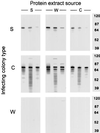Phenotypic switching in the human pathogenic fungus Cryptococcus neoformans is associated with changes in virulence and pulmonary inflammatory response in rodents
- PMID: 9843999
- PMCID: PMC24559
- DOI: 10.1073/pnas.95.25.14967
Phenotypic switching in the human pathogenic fungus Cryptococcus neoformans is associated with changes in virulence and pulmonary inflammatory response in rodents
Abstract
High-frequency reversible changes in colony morphology were observed in three strains of Cryptococcus neoformans. For one strain (SB4, serotype A), this process produced three colony types: smooth (S), wrinkled (W), and serrated (C). The frequency of switching between colony types varied for the individual colony transitions and was as high as 10(-3). Mice infected with colony type W died faster than those infected with other colony types. The rat inflammatory response to infection with colony types S, W, and C was C > S > W and ranged from intense granulomatous inflammation with caseous necrosis for infection with type C to minimal inflammation for infection with type W. Infection with the various colony types was associated with different antibody responses to cryptococcal proteins in rats. Analysis of cellular characteristics revealed differences between the three colony types. High-frequency changes in colony morphology were also observed in two additional strains of C. neoformans. For one strain (24067A, serotype D) the switching occurred between smooth and wrinkled colonies. For the other strain (J32A, serotype A), the switching occurred between mucoid and nonmucoid colonies. The findings indicate that C. neoformans undergoes phenotypic switching and that this process can affect virulence and host inflammatory and immune responses. Phenotypic switching may play a role in the ability of this fungus to escape host defenses and establish chronic infections.
Figures




References
Publication types
MeSH terms
Grants and funding
LinkOut - more resources
Full Text Sources

